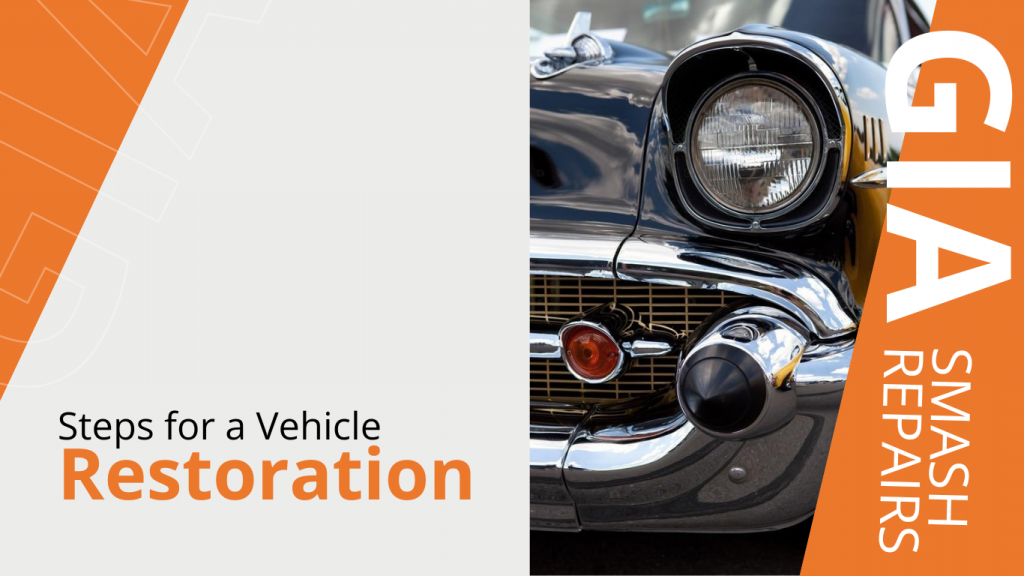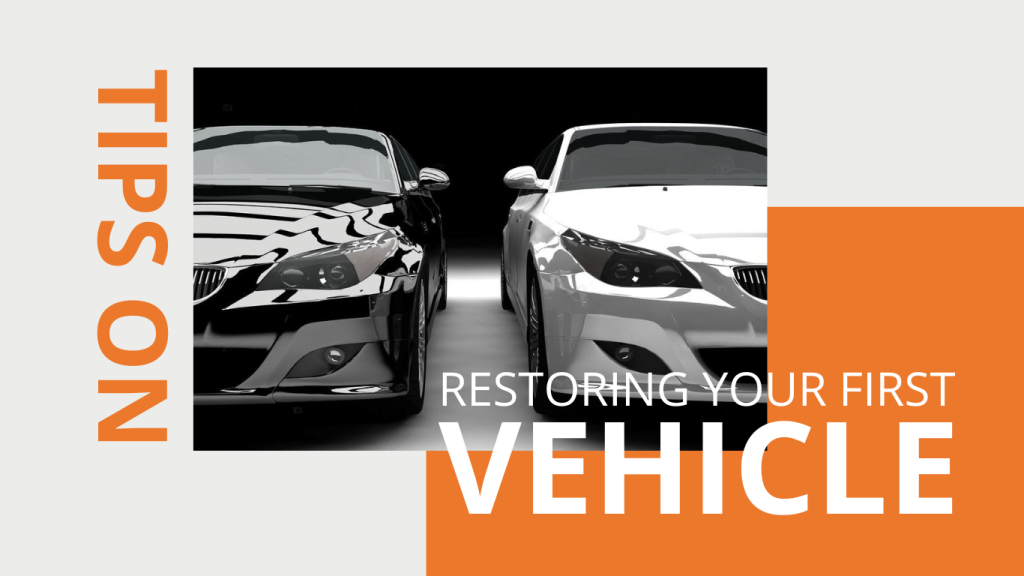Vehicle restoration involves returning a classic or vintage automobile to its original state or enhancing it beyond its original condition. It can encompass a range of tasks, from simple repairs and cosmetic improvements to comprehensive overhauls and reconstructions.

It’s important to note that the specifics of vehicle restoration can differ significantly based on factors such as the vehicle’s type, the scale of the repair, the accessibility of original components, and the vehicle restorers’ skill set. This endeavour demands substantial effort and keen attention to detail, requiring expertise in mechanics, craftsmanship, and a steadfast commitment to maintaining authenticity.
Knowing the basic steps for a successful car restoration is vital because it gives you a clear plan. These steps help you avoid mistakes and keep the historical and visual value of the vehicle intact. Following these steps gives you a better chance of getting a great result. It also helps you manage your time and resources well, ensuring you’re happy with the restoration.
Can You Repair A Car with No Prior Experience?
Repairing a car without prior experience is possible, but it can be challenging and requires careful consideration. While professional expertise is ideal, many beginners successfully tackle simple repairs with the right resources and approach. The advantages of attempting car repairs as a beginner include vehicle restoration cost, self-sufficiency, and learning new skills. Basic tasks like changing the oil, replacing air filters, or changing spark plugs can be good starting points.
Online tutorials, repair manuals, and guidance from experienced friends can provide invaluable assistance. However, for complex issues involving safety systems or critical components, seeking professional help from skilled vehicle restorers is crucial to prevent accidents and further damage. Starting with minor repairs can build confidence and pave the way for acquiring valuable car maintenance skills.
Tips on Restoring Your First Vehicle From A First Time

Restoring your first vehicle can be an exciting and rewarding adventure, but it’s essential to approach it carefully and carefully. Whether you’re a beginner or have some DIY experience, taking on a vehicle restoration project requires a solid plan and a willingness to learn. To help you make the most of this experience, here are some essential tips:
Start Small
Begin with manageable tasks that match your skill level. Simple repairs and cosmetic improvements can boost your confidence before tackling more complex aspects of restoration.
Research Thoroughly
Learn about your vehicle’s make, model, and year. Gather information on its original specifications, parts, and joint issues. This knowledge will guide your restoration efforts.
Set a Budget
Determine how much you’re willing to invest in the car paint restoration project—factor in the cost of parts, tools, equipment, and potential unexpected expenses.
Create a Plan
Outline the scope of your restoration project. Decide which areas need attention – mechanical, electrical, bodywork, interior – and prioritize tasks accordingly.
Document Everything
Take photos and notes as you disassemble the vehicle. This documentation will be invaluable during reassembly, ensuring every part finds its proper place.
Learn New Skills
Embrace the opportunity to acquire new skills, whether welding, painting, or engine work. Online tutorials, manuals, and forums can be great resources.
Quality Over Speed
Take your time to do things right. Rushing through the process can lead to mistakes that are costly to fix later.
Be Realistic
Understand your limitations and when to seek professional help. Some tasks, such as engine rebuilds or complex electrical work, require expertise beyond your current level.
Stay Organized
Keep your workspace tidy and well-organized. It will save you time and frustration when searching for tools or parts.
Celebrate Milestones
Acknowledge and celebrate each accomplishment, whether getting the engine running or finishing the bodywork. It will keep you motivated throughout the project.
Remember, your first car restoration is a learning experience. Don’t be discouraged by mistakes; view them as opportunities to grow and improve your skills. With dedication, research, and a passion for automobiles, you can successfully restore your first vehicle and create something unique.
10 Common Mistakes When Restoring Cars That You Should Not Commit

Restoring cars is a mix of being creative and good with details. If you make mistakes while fixing up a car, it can cause problems with money, safety, how real the vehicle looks, and how happy you feel about it.
To do a good job, you need to plan things well, pay close attention to small things, and avoid making the usual mistakes. Also, it helps to learn from what others have done wrong and listen to advice from people who know a lot about this. This way, you can make sure your car fixing journey feels fantastic and you’re proud of what you’ve done with the car’s history.
Avoiding common mistakes is essential for a successful outcome when embarking on car restoration.
Here are the top 10 errors to evade:
- 1. Lack of Planning: Create a comprehensive plan detailing each restoration step to ensure clarity and efficiency.
- 2. Underestimating Costs: Accurately estimate expenses, including parts, tools, and unforeseen challenges, to avoid financial strain.
- 3. Insufficient Research: Investigate the vehicle’s history, parts availability, and specifications to ensure accurate restoration.
- 4. Neglecting Professionals: Consult experienced restorers or mechanics for guidance, benefiting from their expertise.
- 5. Safety Oversight: Prioritize safety during repairs and modifications using proper tools and techniques.
- 6. Excessive Customization: Maintain the value and appeal of the vehicle by finding a balance between customization and its original authenticity.
- 7. Rushing the Process: Allow ample time for a thorough restoration, ensuring attention to detail and quality work.
- 8. Poor Documentation: Thoroughly document the vehicle’s removal process to help with its correct reassembly and ensure clarity.
- 9. Incorrect Part Usage: Use authentic and compatible parts to maintain the vehicle’s integrity and value.
- 10. Neglected Maintenance: Post-restoration, adhere to regular maintenance to preserve the fruits of your labour.
Ultimately, being aware of these common pitfalls empowers you to undertake the restoration process confidently, increasing the likelihood of achieving a successful outcome in which you can take pride.
10 Advantages of Getting Your Car Restored
Vehicle restoration is like giving old cars a new life. It’s important because it brings back the history and coolness of old vehicles. Many good things come from restoring cars. It makes the cars worth more money, lets you make them unique, and feels fantastic to bring old cars back to life. You must plan, research, and pay attention to small things to do it well.
Restoring a car offers a host of benefits that go beyond just fixing it up. Here are ten advantages of getting your vehicle repaired:
- 1. Preserving History: Restoring a car keeps its unique history and design alive for future generations.
- 2. Enhancing Value: A properly restored car can significantly increase its resale value.
- 3. Personalization: You can customize the restoration to make the car reflect your taste and style.
- 4. Learning Experience: Restoring a car teaches you valuable mechanical and technical skills.
- 5. Connection to the Past: Restoring an old car allows you to connect with the automotive heritage of its time.
- 6. Sense of Accomplishment: Completing a restoration project brings excellent achievement.
- 7. Unique Ownership: A restored car stands out and can be a conversation starter in gatherings.
- 8. Increased Durability: The car’s structural integrity and durability can be improved through restoration.
- 9. Eco-Friendly: Restoring an old car is environmentally friendly as it reduces the need for new manufacturing.
- 10. Nostalgia and Sentiment: Restoring a car from your past or family history evokes nostalgic feelings and creates lasting memories.
Successful car restoration requires patience, dedication, and attention to detail, but the rewards can be truly fulfilling. If you’re searching for superior vehicle restoration near me, look no further than GIA Smash Repairs. Our team of experts is dedicated to providing top-notch craftsmanship and quality service. Whether aiming to restore a classic car to its former glory or seeking comprehensive repairs, GIA Smash Repairs is your trusted destination.
